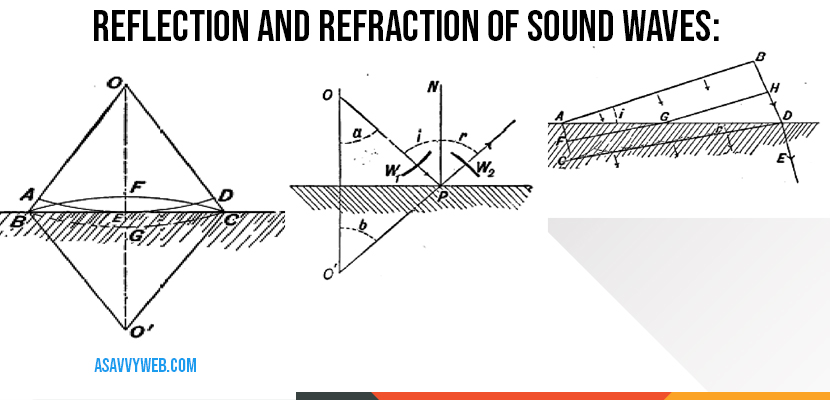Reflection of Water Waves:
When a water wave meets and immovable obstacle it is turned back or reflected. Since, the obstacle does not move it cannot receive energy from the incident wave which got hit and therefore the reflected wave carries the energy away. Each point of the obstacle reacts against the wave which meet it and so produce a periodic disturbance and may be regarded as a center from which waves are sent out. The reflected wave as a whole is the resultant of these little waves coming from each point of the obstacle.
Let’s Suppose a wave from a center O, meets the straight wall BC When in the position of the dotted line BGC, but since after reflection it has the same velocity as before, the reflected wave will at each point have gone back from the wall as far as it would have passed the line BC if the wall had not been there. The front of the returning wave BFC has therefore the same curvature as BGC if the wall is flat. The returning wave is therefore circular having its centre at the point O which is as far back of the wall as the centre O is the front of it and the line OO’ is at the right angles to the wall.
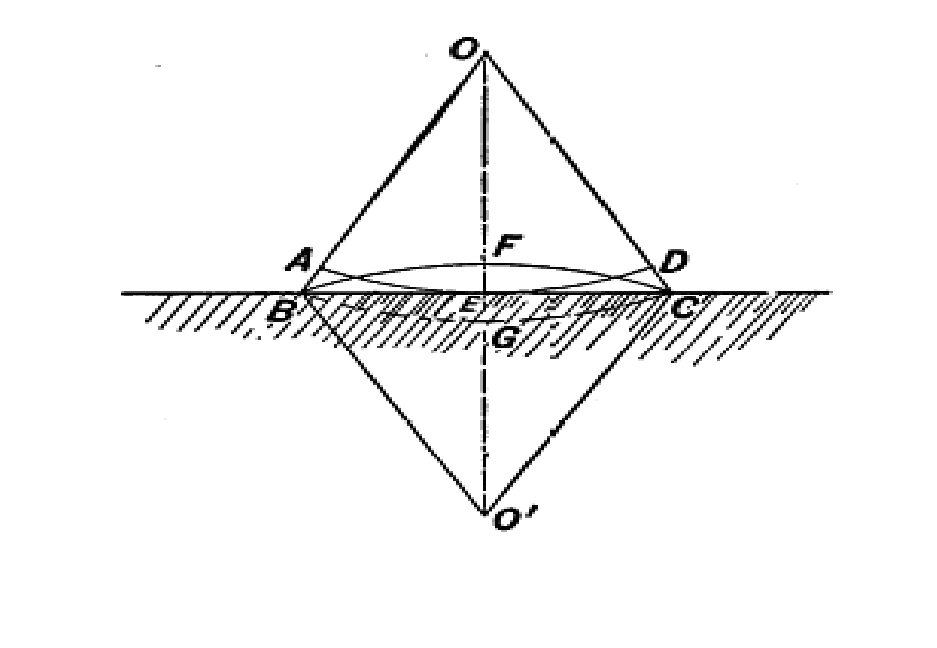
Another method of looking at this subject is interesting. The effect of the vertical wall is to oppose any forward or backward motion of the water particles next to it without interfering with vertical motions. Let us now imagine the wall removed and that whenever a wave starts from O and exactly equal wave sets out from O’. The waves will meet along the line BC and the forward or backward moment due to the one will be exactly balanced by that of other, w hile their vertical movements will be added. There results therefore an up-and-down oscillations along the line BC exactly as if the wall were there.
On each side of the line BV there will be waves coming toward the line and others goong bacl from it exactly as if reflected from it. Ans indeed they may be properly regarded as reflected for there is no tranfer of energy across the line BC because there is no forward motion across that line and if a thin wall were slipped in along BC separating the two system of waves the motion would not be changed on either side.
Angle of Reflection:
When a wave front meets a reflecting s surface obliquely, the D direction of the wave front and its direction of propagation are changed. As W1 is a portion of wave front approaching P where it is reflect afterward advancing as W2 as if came from O`. The angel i between the direction of advance of the incident wave rand the normal to the surface is called the angle of incidence, while the angle r between the direction in which the reflected wave moves and the normal N is called the angle of reflection . The angle of reflection is equal to the angle of incidence. For the angle a and b are clearly equal and the angle I is equal to a, and r is equal to b since the lines OO1 and NP are parallel.
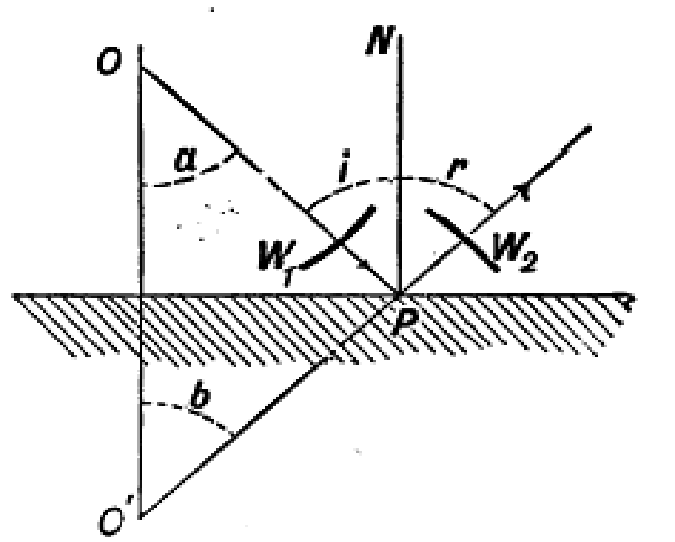
It is interesting to see how the reflected wave may be regarded as the resultant of little waves coming back from each point of the reflecting surface. Let AB be a wave front meeting the reflecting surface AC to A. The disturbance at A cause a little circular wave to go back which will have a radius AD equal to BC by the time that the wave front at B has reached c. since the velocity of the returning wave is the starting backward from F when the advancing wave has reached the position FG will have a radius FK equal to GC when the wave front at B reaches C.
From each point in succession of the reflecting surface between A and C these elementary wave spread out just as from A and F, in arcs of circles whose centres lie on the line AC. The envelope of these circles is the line DC which is tangent to all of the, All these elementary wave therefore act together and combine to produce a new wave front along the line DC. Since AD is equal to BC and is at right angles to the tangent DC, just as BC is at right angles to AM the two triangles ADC and ABC are equal and the angle of incidence BAC is equal to the angle of reflection DCA.
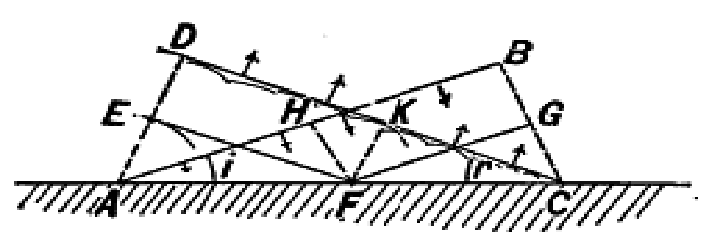
While the elementary waves are conceived s spreading out in circles in every direction they produce an effect only along the wave front DC where all act together, for it may be shown that they interfere with each other direction, such as off to one side, unless the reflecting surface is very small. If the distance AC is not more than the length of a wave, regular reflection will not take place, but the reflected wave will spread out in all directions as if the reflecting surface were the centre of disturbance.
Refraction of Waves:
When waves pass from one medium into another there is generally a change in velocity, which causes the direction of the wave to change when it meets the surface of separation obliquely.
Let AB represents the advancing wave front, meeting at A the second medium where the velocity is less. While the wave front advances from B to D is the first medium, the wave front will be CD tangent to the elementary waves from A and from all points between A and D. The direction of advance of the wave is changed toward the perpendicular from BD to DE. An intermediate position of the wave, where part is in one medium and part in the other show a sharp bend at G.
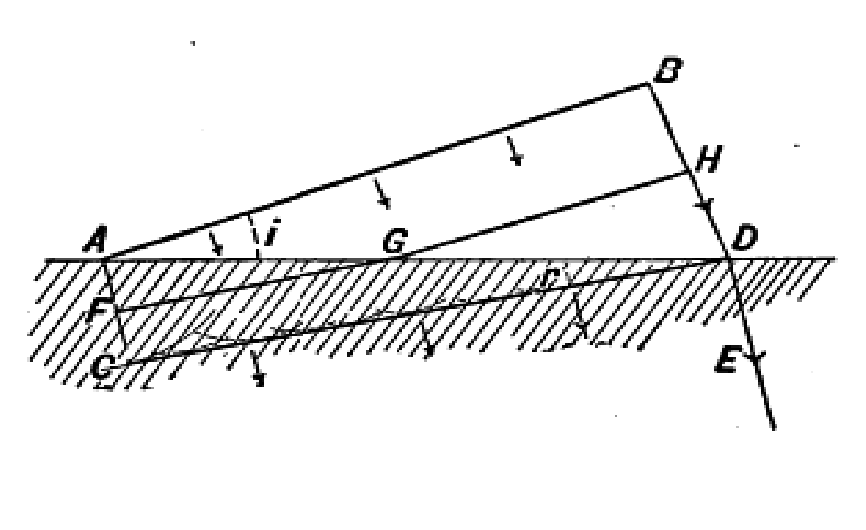
If the velocity in the second medium were greater than that in the in first the waves would become refraction more oblique to the surface of separation instead of less oblique as in the case illustrated.
The refraction most commonly noted in water waves is when they run obliquely into shoal water near shore, where their velocity is retarded. The effect is to swing the wave front around more really parallel with the shore.
Reflection of Sound:
In the reflection of sound the same principle apply as in case of water waves. Sound waves reflected from large flat surface appear to come from a point as far behind the surface of the surrounding body is in front of it. Echo’s from building, cliffs and even from a wooded hillside are familiar examples of the reflection of sound.
If there are a series of cliffs or shoulder of rock at different distance multiple echo’s are heard. A pistol shot from boat on a smooth lake comes as a single sharp sound followed by faint echoes from the distant shores, but if the water is rough the shot is followed by a reverberating roar as the sound comes back reflected from wave after wave.
By Means of large parabolic mirror the tick of a watch placed at its focus is reflected so that it may be heard 50 ft away by an observer having his ear at the point on which the reflected waves are converged. The proper position to hold the ear may be found by observer where the image is formed of a light placed at the focus of the mirror, showing that the law of reflection is same for sound as for light.
A watch is used in this experiment because the waves of sound which it gives out are so short, even relative to the size of the mirror, that the law of regular reflection holds.
In rooms with arched ceilings focal points may sometime be found such that sounds going out from one point are converged toward the other. A person holding his ear at one point can hear the slightest whisper coming from other.
There are other kinds of whispering galleries in which the effect depends not on regular reflection, but on the gradual deflection of a wave as it runs along a smooth surface.
Reflection and Refraction of Sound Waves:
Wheneversound waves meet the surface between two media usually both reflation and refraction take place. If there is a very great change of density and elasticity most of the energy goes in to reflected wave, and the refraction will be slight. On the other hand if the two media like two starts of air at different temperatures, differ only slightly in their properties most of the energy will be transmitted in the refracted waves in to the second medium and but little will be reflected back from the surface.
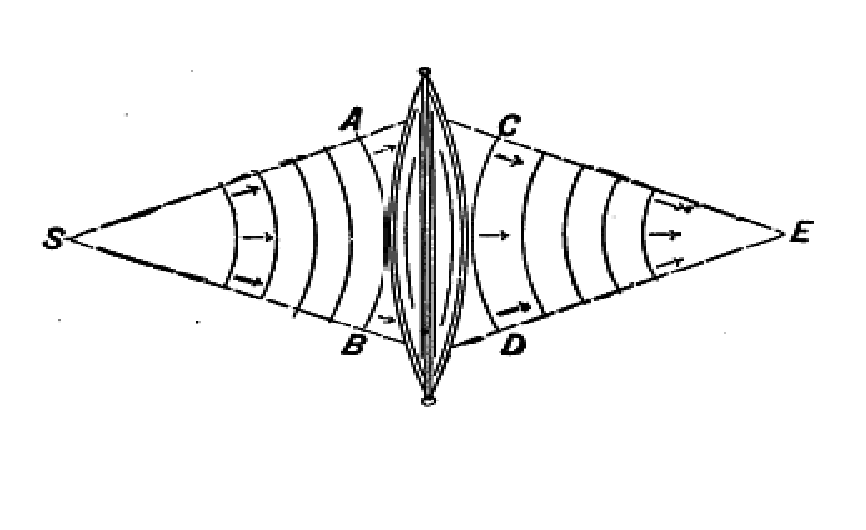
If a lenticular bag of thin rubber is filled with carbonic acid gas (CO2) in which sound travels more slowly than in air, the sound from the tics of a watch will be concentrated at a focus conjugate to the position of the watch, just as light is converged by a lens of glass which retards its waves. For in passing through such a lens the middle part of the wave AB is more retarded than its edges, so that it is transformed into the form CD which is concave toward the eat at E.

